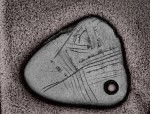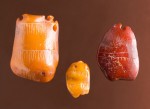 Archaeologists excavating the Early Mesolithic site of Star Carr in Yorkshire have unearthed a shale pendant with engraved lines. This is the first pendant with an engraved design from this period found in Britain and it’s the only engraved pendant made of shale ever discovered in Europe. It was found in a sediment layer that was once shallow water about 30 feet from the shore of the paleo-Lake Flixton. The organic material in the sediment is still being dated, but preliminary estimates date the sediment deposit to around 11,000 years ago.
Archaeologists excavating the Early Mesolithic site of Star Carr in Yorkshire have unearthed a shale pendant with engraved lines. This is the first pendant with an engraved design from this period found in Britain and it’s the only engraved pendant made of shale ever discovered in Europe. It was found in a sediment layer that was once shallow water about 30 feet from the shore of the paleo-Lake Flixton. The organic material in the sediment is still being dated, but preliminary estimates date the sediment deposit to around 11,000 years ago.
When it was first discovered it just looked like a piece of stone. The hole that marks it as a pendant was clogged with sediment and the very faint engravings weren’t visible. It was only when it was lifted out of the ground that the sediment fell out of the perforation and the engravings were spotted.
 Just one side of the shale is engraved with very small lines at angles from each other of a kind defined by the first excavator of Star Carr and expert in Early Mesolithic art Grahame Clark as the barbed lines type C. They were incised on the stone. Incision was the most common method of Early Mesolithic engraving (as opposed to boring and drilling) and geometric designs engraved on portable objects were typical of the period in northern Europe.
Just one side of the shale is engraved with very small lines at angles from each other of a kind defined by the first excavator of Star Carr and expert in Early Mesolithic art Grahame Clark as the barbed lines type C. They were incised on the stone. Incision was the most common method of Early Mesolithic engraving (as opposed to boring and drilling) and geometric designs engraved on portable objects were typical of the period in northern Europe.
 A perforated, engraved shale pendant is unique; the usual materials were amber, antler and bone. Grahame Clark’s Star Carr excavations in the 1950s and the current excavation, which began in 2013, recovered a number of unengraved shale beads, distinct from the pendant because the perforation is in the center rather than the top. The hole in the top suggests the object was suspended from a necklace.
A perforated, engraved shale pendant is unique; the usual materials were amber, antler and bone. Grahame Clark’s Star Carr excavations in the 1950s and the current excavation, which began in 2013, recovered a number of unengraved shale beads, distinct from the pendant because the perforation is in the center rather than the top. The hole in the top suggests the object was suspended from a necklace.
 The team studied the engravings with integrated light microscopy, reflectance transformation imaging (RTI) and scanning electron microscopy (SEM). SEM and RTI proved particularly effective at identifying the order of engraving and showing the impressive precision with which these angled lines, some of which are teeny tiny, were inscribed. They found that the central groove was done before the lines parallel to it, then the tiny right angle lines, then the grooves perpendicular to the central one, the tiny lines connected to them and then the rest of the lines in the field. The groups of lines were engraved in at least two, possibly more, phases.
The team studied the engravings with integrated light microscopy, reflectance transformation imaging (RTI) and scanning electron microscopy (SEM). SEM and RTI proved particularly effective at identifying the order of engraving and showing the impressive precision with which these angled lines, some of which are teeny tiny, were inscribed. They found that the central groove was done before the lines parallel to it, then the tiny right angle lines, then the grooves perpendicular to the central one, the tiny lines connected to them and then the rest of the lines in the field. The groups of lines were engraved in at least two, possibly more, phases.
The order of engraving is significant because it may be an important clue to the purpose of the lines.
Evidence from surviving traditional shamanic societies in northern Asia and elsewhere – where similar markings (often on wooden ceremonial batons) are still used – suggest that the lines on the recently discovered Mesolithic Yorkshire pendant probably represent the number of large animals (perhaps, in this case, red deer) killed on hunting expeditions. However, some of the lines could also represent the number of ritual songs and dances performed by the group when it returned with the dead deer to their camp. […]
Modern ethnographic parallels suggest that the proper recording of kills and associated rituals would have been seen as essential to guaranteeing future hunting success.
The deliberate faintness of the engravings may have been in order to ensure that the information on the pendant remained, in effect, a secret record of kills and related rituals that was accessible only to particular individuals or groups.
Evidence of ritual activity at the site abounds. The most recent excavation has unearthed six ritual headdresses made from the skulls and antlers of red deer, and earlier excavations turned up 21 more of them. Given the rarity of the pendant and the great effort made to engrave it, it’s a strong possibility that it is related to the rituals practiced in prehistoric Star Carr.
The pendant was 3D scanned so it could be virtually examined from all sides. You can explore it yourself with this 3D scan viewer. A most wonderful paper full of details about the find can be read in its entirety here.
That knocks astronautical urine into a cocked hat.
Hm, perhaps I could have phrased that better.
I wonder how they made the scores and hole? Flint?
The hole was drilled, probably with a bow-drill. The point could have been flint or sharpened bone. My guess is that the lines were carved with flint, just because the smallest ones require the very thin edge and precision that can be achieved more readily with flint than with bone. Shale is delicate and easily carved, though, so it’s not out of the question that a bone shiv was used.
My first thought was, “it’s a map, or an aerial picture of a farm.” This is why I leave the archaeology to the pros.
A more-hunter’s than gatherer’s- Mesolithic tax declaration ?
Whatever the true meaning of that pendant might be, it lacks the ornamentation of the more decorative amber ones, and indeed it looks more like some form of record or notice. Contrastingly, however, the thing is with roughly 4cm rather tiny. Would a hunter or an observer of astronomy, therefore, scribble on something as tiny as this ?
If, however, a Mesolithic hunter cuts out the heart of -let’s say- a deer (i.e. similar to an Eskimo with a freshly killed seal), wouldn’t it resemble that shale pendant with its coronary arteries ?
P.S.: Maybe there is no meaning at all to this 😆
“some form of record or notice”: then it would be classified as writing. Golly, that’s a thought.
It does look eerily like a map, doesn’t it? Maybe it is. I think sometimes we go out of our way to avoid imposing our world view on artifacts (perhaps to make up for the ethnocentric archaeologists who did so much of it). But these are humans like us- why couldn’t it be a map? How handy to have a guide hanging from one’s neck. Be that as it may (for other minds than mine), it also reminds me of a situation when I was an anthropology student. Our professor, a woman, was showing some photographs of animal bones found at one of her sites, with markings in groups of 30 to 33. She asked us our thoughts. Of course the first thoughts mentioned (largely from the guys) were tracking game, or number of animals killed. Another thought it might be some kind of cycle. The moon? Timing was off.
You could see the lightbulb going off in some of the women’s eyes. Almost simultaneously, several of us said “menstural cycles”. Like the marks on our personal calendars. Our professor grinned. We then had a good discussion about why is it that it never seems to occur to the (mostly male) people working these sites that not everything refers to “male activities”.
I think the distinct phases of carving argue against it being a map, as do the faintness of the lines and the small field. A map has to be clear and easily read to work.
Dearieme, it does not take writing to take records.
How do you think ancient astronomers got to know what they actually did know ? What it takes here are long-term observations (sometimes over decades !) and tradition.
“Inscribed bones and tortoise shells from the Shang dynasty reference solar eclipses.” – Mesolithic bones and stones with similar inscriptions have been found in France (no reference at hand).
Wikipedia has references to e.g.:
Golden_hats [bronze age]
Metonic_cycle [and others]
Goseck_circle [49th century BC]
“it does not take writing to take records”: my proposition is that you are wrong. The records mean that writing, however primitive, is in use. That is how I’d look at it, though I’ll grant you it’s amateur of definition. You can have writing without sonnets, I think.